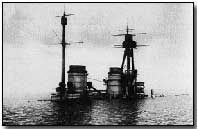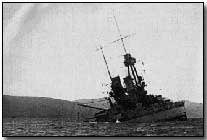Feature Articles - Scuttling at Scapa Flow
 According to the terms of
the armistice,
Germany was obliged to hand over and surrender all her U-boats and about 74
surface warships whose ultimate fate would be determined later on. On
19 November 1918 the German naval force set sail for the Firth of Forth
where the British would check that the disarmament was complete before
moving the ships to other ports to be interned. A German torpedo-boat
strayed off course and was sunk by a mine.
According to the terms of
the armistice,
Germany was obliged to hand over and surrender all her U-boats and about 74
surface warships whose ultimate fate would be determined later on. On
19 November 1918 the German naval force set sail for the Firth of Forth
where the British would check that the disarmament was complete before
moving the ships to other ports to be interned. A German torpedo-boat
strayed off course and was sunk by a mine.
The German fleet arrived at the Firth of Forth on the morning of 21 November and were met by an Allied force of about 250 ships under Admiral Beatty. At 3.57 p.m. the German flag was ordered to be hauled down and the ships were inspected by the British to see if disarmament was complete. From the 22-26 November the British moved the German ships in groups to Scapa Flow, where they all arrived by 27 November.
By mid December the 20,000 crew who had sailed the ships to Scapa Flow were reduced to a caretaker crew of about 4,800 men and officers. In June 1919 the crews were reduced to Royal Navy caretaker levels of about 1,700 men.
During this time peace talks had been dragging on, with several extensions to the armistice. The Allies were divided over the fate of the ships with many countries wanting a share, while the British as the key naval power at the time were less keen to boost the strength of rival navies (American and French in particular). The final version of the Treaty of Versailles involved the surrender of the interned ships.
Meanwhile the German commander, Ludwig von Reuter, was fearful that the British would suddenly and without warning seize his ships and therefore began to take preparations to scuttle the fleet. On the morning of 21 June the British battleships at Scapa Flow left for exercises. Admiral Reuter chose this moment to start the scuttling of his interned vessels.
At 10.30 AM he signalled the fleet "Paragraph eleven. Confirm." - which was the code for immediate scuttle. Although the British battlefleet returned full speed they were only able to rescue the battleship Baden and three cruisers. In the confusion nine German sailors were shot dead, they could be considered to be the last kills of WWI.
 Over
400,000 tons of warships were sunk. Officially the British were
outraged but in private there was a sense of relief that the problem of what
to do with the interned fleet was now solved.
Over
400,000 tons of warships were sunk. Officially the British were
outraged but in private there was a sense of relief that the problem of what
to do with the interned fleet was now solved.
This way "rival" fleets would not be able to get their hands n these modern ships.
Considerable efforts were made by British Intelligence to prove that the scuttling had been ordered by the government in Berlin but they never found any proof.
In all 5 battlecruisers (Seydlitz, Moltke, Von der Tann, Derfflinger, Hindenburg), 10 battleships (Kaiser, Prinzregent Luitpold, Kaiserin, König Albert, Friedrich der Grosse, König, Grosser Kurfurst, Kronprinz Wilhelm, Markgraf, Bayern), 5 cruisers and 31 other ships were successfully sunk.
Article and photographs contributed by Frederik Dewaele
The "Blue Max" was a reference to the prestigious German Pour le Merite medal.
- Did you know?
